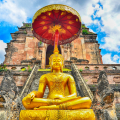WAT CHEDI LUANG
A temple known as Jedi Luang housing a statue of Buddha (Phra Chao Attarot), standing in Abhaya mudra position
This temple, also known as Jedi Luang, or temple of the great Stupa, is particularly revered in Chiang Mai. On this site originally, there were two small temples, Wat Tham Ho and Wat Sukmin, which served as the base for the construction of Wat Chedi Luang. This construction began at the end of the 14th century, initiated by King Saeng Muang Ma to shelter the ashes of his father. The building was enlarged by the following kings to reach its final form in 1475 under the reign of King Tilokarat. Its viharn houses a statue of Buddha standing in the mudra position of Abhaya (the dispelling of fear with a gesture of the hand, palm facing visitors) known as Phra Chao Attarot. Made of an alloy of bronze and mortar, this Buddha dates back to the time of the founder of the temple. The interior of the viharn is particularly interesting with its round stone columns supporting a red ceiling. Behind the temple, the ruins of Chedi Luang. Built in 1391, the chedi was originally 86 meters high. Its base is 44 meters wide. Each side of the chedi has an altar with a seated Buddha, which could be reached by monumental stairs. These niches are guarded by terrifying looking stone nagas. Impressive elephants stand guard halfway up to the platform. In 1545, an earthquake partially destroyed the Chedi, the great spire was destroyed and lowered it to a height of 60 meters. Nevertheless, it remained until the end of the 20th century the highest building in the city and is still inside the old city walls. The famous Emerald Buddha, Thailand's holiest religious representation (now at Wat Phra Kaew in Bangkok), was kept in this temple from 1458 to 1550, then moved to Luang Prabang in Laos, before finally reaching the present capital of the kingdom. At the beginning of the last century, until 1928, several viharn were built next to the temple. Many sanctuaries are still very much frequented by dozens of monks. Next to a Bodhi tree, which the inhabitants of Chiang Mai say that if it dies, the city will suffer a terrible catastrophe, is a stone symbolizing the foundation of the city (Lak Muang). According to the legend, this is where King Mengrai escaped lightning during a storm. In the enclosure is also the Wat Phan Tao, whose wooden viharn reveals magnificent sculptures, and a superb large reclining Buddha.
Did you know? This review was written by our professional authors.
Book the Best Activities with Get Your Guide
Members' reviews on WAT CHEDI LUANG
The ratings and reviews below reflect the subjective opinions of members and not the opinion of The Little Witty.

